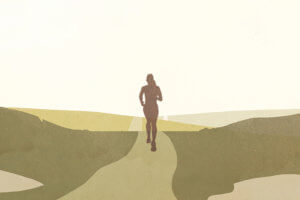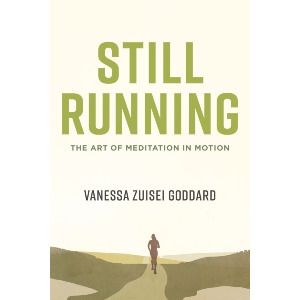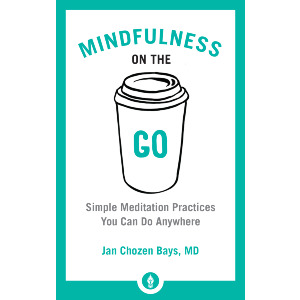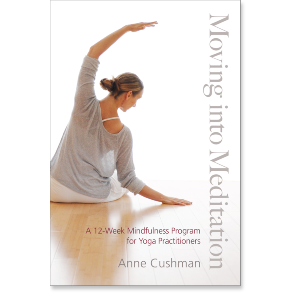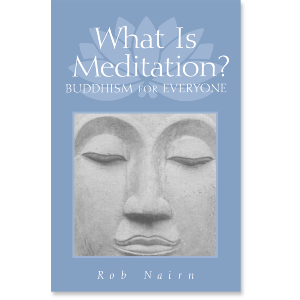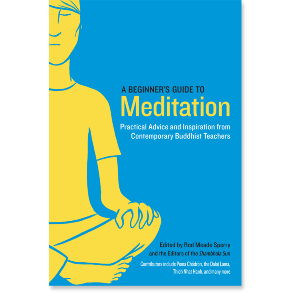From Still Running
On a cool spring morning, a Zen teacher and his student are going for a walk. The last traces of snow have melted from the ground, and tiny buds are beginning to show on the tips of the cherry branches. Bundled in their robes, master and disciple walk easily as the day slowly grows warmer. Their walk leads nowhere in particular. They are walking simply to walk, while all around them birds chirp quietly as if trying on their voices for the day.
After a while, the two men come upon a stream. The teacher sits down on the grassy bank with his back against the trunk of an alder. Like a puppy, the student plops himself on the ground, his legs crossed under him. His every movement says he’s eager to impress the master. Quiet on the walk, he now prattles on about this and that teaching, peppering his own thoughts with bits of relevant commentaries. Every now and then he sneaks a glance at his teacher, checking his expression. The older man just listens, his eyes half-closed against the glare of the sun reflecting off the water.
“How is your zazen practice?” the teacher asks when the student finally grows still.
“Oh, you know,” says the young man without looking at his teacher. In his mouth is a young grass shoot and he is relishing the bitter, lemony taste. “The breath is so boring.”
Like a flash, the teacher throws himself on his student and with one quick move, rolls the younger man’s upper body into the stream. He places one strong hand between his student’s shoulder blades, the other on the back of his head, and pushes down hard to hold him underwater. Caught off guard, at first the student freezes. Then, when he realizes his teacher will not let go, he begins struggling. He tries to reach back to grab the older man’s robe, but immediately his arm is pinned down under the teacher’s leg. Desperate now, the young man tries to get purchase on the grass to wriggle out from under the teacher’s grasp, but he can barely move. Another long moment passes before the teacher yanks him out of the water by pulling on his collar. Completely drenched, the student sits on the grass coughing and gasping for breath as the teacher looks at him searchingly.
“Still boring?” he asks.
The Four Foundations of Mindfulness
Boredom thrives on inattention. We take, on average, twenty thousand breaths a day. Our lives literally depend on this most basic function, yet we are usually unaware that it’s happening. The breath is the vehicle of our life force; without breath, we cannot live. And without attention to our breath, we live half-consciously. That is why so many contemplative practices use the breath as the primary object of meditation.
In the Satipatthana Sutta (The Discourse on the Four Foundations of Mindfulness), the Buddha describes a practitioner who, sitting down quietly to contemplate her breath, is aware of it in this way:
Mindful, she breathes in and mindful, she breathes out.
Thinking, “I breathe in long,” she understands when she is breathing in long.
Thinking, “I breathe out long,” she understands when she is breathing out long.
Thinking, “I breathe in short,” she understands when she is breathing in short.
Thinking, “I breathe out short,” she understands when she is breathing out short.
Notice that the Buddha doesn’t say the practitioner needs to control her breath. He doesn’t say she should breathe long, deep, even breaths. He says she’s mindful of the breath just as it is. Being mindful, she notices when her breath is long or short. Being mindful, she sees when she’s breathing fully and when she’s not. She knows when her breath is ragged and shallow, filled with tension and anxiety, or deep and even, quiet and relaxed.
The Buddha considered the breath the most important object of meditation—the gateway to enlightenment. Even after decades of practice, he periodically took time away from his sangha to go on solitary retreat in order to practice anapanasati, “mindfulness of breathing.”
Mindfulness, or sati, is the ability to remember or to keep an object in mind. As I mentioned before, it is also the ability to see the object we are concentrating on: the breath, a thought, a feeling. Right mindfulness is made up of what in Buddhism are called the Four Foundations of Mindfulness: mindfulness of the body (especially of the breath), of feelings, of mind, and of thoughts or mental formations. To study these foundations, a practitioner uses mindfulness, alertness, and resolve, all of which rely on appropriate attention. “Appropriate” here specifically means attention that gives us insight into the problem of suffering and its alleviation and more broadly, attention that matches the object of our meditation. This is important because it is possible to be concentrated yet mindless. It is possible to be very focused and not see the object we’re focusing on at all.
We take, on average, twenty thousand breaths a day. Our lives literally depend on this most basic function, yet we are usually unaware that it’s happening.
Halfway through my first weeklong sesshin, or silent meditation retreat, I was assigned to work in the monastery garden. The gardener was an old British nun with a singsong voice and a throat-clearing habit—a nervous little squeak with which she prefaced every sentence, as if she were unsure whether she should be speaking at all.
She walked me over to one of the raised garden beds and asked me to weed it. I suppose I looked like an outdoor type, because she didn’t check whether I’d ever tended a garden. I hadn’t. But how hard can it be? I thought, and plunged my hands into the dirt with relish.
It was July, and already warm though it was only eight thirty in the morning. My sleeves rolled up to my shoulders, I crouched next to the bed and began to pull weeds as fast as I could, determined to show the old nun that no one could work faster than I could. I had been doing zazen for three days, so my mind felt relatively quiet, but I was also buzzing with energy. I worked quickly—feverishly, really—without giving much thought to what I was doing.
At one point, a voice in my head interrupted my trance. These weeds are growing awfully straight. I felt a quick tightening of my stomach, a warning sign that I chose to ignore. I was doing too well to stop, I thought, so like an ox I lowered my head and kept going.
At the end of an hour and a half, when the work period was over, I proudly called over the nun to show her my work. She took one look at the bed and quickly walked away, muttering to herself. Confused, I stood where I was and waited. On the other side of the garden now, the nun stood a couple of feet from the fence, her back to me. She looked up at the sky, then down at the stones under her feet. She shook her head, shrugged her shoulders, then came back to where I was standing.
“You pulled a whole bed of carrots,” she said, her voice rising past singsong into a cry.
It was a long time before I was assigned to the garden again.
Every day there are a thousand ways in which we miss what’s right before our eyes.
Unfortunately, this kind of mindlessness is common. In our attempt to concentrate, we stop thinking or discerning. This is not what the Buddha had in mind, of course, when he spoke of single-pointed attention. Pulling carrots for weeds is one thing, yet every day there are a thousand ways in which we miss what’s right before our eyes. Almost invariably, the result is more suffering for us and those around us.
Think of a morning when you woke up with a vague feeling of discomfort. Maybe you had a bad dream. Maybe you ate something that upset your stomach and now you’re feeling off. Maybe you’re processing an emotion you’re not even aware of. Not being aware, you walk around feeling out of sorts. But you don’t like this, so you are also unconsciously looking for an emotional release. Looking, you will find. The stack of bills your partner has left on the dining room table, your son’s muddy boots by the door, your roommate’s makeup on the dresser—these are all perfect excuses to start a fight. Before you even know what’s happening, you’re yelling, dredging up every instance of carelessness the other person has shown during the past ten years. If you’re lucky, they’ll know to walk away and not engage again until you’ve come to your senses. If you’re not, they’ll join the shouting match.
A consistent zazen practice helps us to quiet the noise of our minds through the development of concentration, and mindfulness helps us to pay attention to our experience in a very basic, unfiltered way. In the example above, mindfulness helps us to first realize that we’re feeling something. The next step is to discern what we’re feeling and how to respond to it skillfully instead of reactively.
In the Sedaka Sutta, the Buddha teaches his monks about mindfulness by giving them the following metaphor. Imagine a man, he says, who craves pleasure and avoids pain, who wants to live and does not want to die. Now imagine this man has been charged with carrying on his head a bowl filled to the brim with oil that he must deliver to a beauty queen who is singing and dancing in front of a throng of adoring fans. Carefully the man must walk through the crowd without spilling a single drop, for if he does, a swordsman walking behind him will chop off his head.
“What do you think, friends?” says the Buddha to his monks. “Will this man let himself be distracted?”
“No, of course not,” they say.
“Well,” he says, “the bowl of oil is mindfulness. This is how you should train yourselves in mindfulness of the body. Give mindfulness the reins, and take it as your ground; steady it, consolidate it, and undertake it well.”
Taking mindfulness as our ground means remembering to pay attention moment to moment. It means remaining alert and resolute in our desire to be awake and present to our lives. Why? Because as this unusual sutra points out, our lives actually do depend on it.
Reclaiming Our Lives
Years ago, I watched a gymnast perform a complicated routine on a balance beam at a circus. Two burly twins were carrying the beam on their shoulders, and every time the gymnast did a flip or a jump, they shifted the beam slightly in order to catch her.
After a particularly harrowing move, it occurred to me that, given the gymnast’s line of business, she couldn’t afford to not be present. A momentary slip of focus, a split-second wavering of attention, and she’d break an arm or worse. And although her act was short—seven or eight minutes at most—she repeated it in exactly the same way day after day, sometimes twice a day, for weeks on end. Like the man with the bowl of oil on his head, her life depended on her ability to remain mindful.
Abashed, I thought of the thousands of small deaths I let myself die in a day—all the many moments in which I am simply not present. Putting on my clothes, sitting at the doctor’s office, surfing the web, I let myself miss accumulated days, months, maybe years of my life, as if I were going to live forever. As if being asleep to my life has no consequences.
I once heard a teacher say that returning to our breath is nothing less than reclaiming our lives. I believe he was right. Every time we come back to the breath, we return to our bodies and to this present moment, where our lives are actually taking place.
Practicing mindfulness of the breath is to give sati the reins, as the Buddha said. It is to take it as our ground, our anchor. In fact, I’ve often used this very image when I’m feeling unfocused, tired, or agitated. On the inhale, I let my hara be suffused with breath. Then I picture the exhale as the anchor holding me steady in the roiling waters of my mind. Resting my awareness on the expansion and contraction of my abdomen, I let all thought, all feeling, all sensation, be held by this breath anchor.
I once heard a teacher say that returning to our breath is nothing less than reclaiming our lives. I believe he was right.
Over the years I’ve seen there is no storm that my breath cannot weather. Sometimes the waters are calm and my boat steady. Sometimes I find myself in the middle of a hurricane in what feels like a flimsy wooden raft. Yet my experience tells me that I have the ability to ride the waves no matter their size, and that, the closer I get to my breath, the more strength and stability I have.
A Zen poem says:
Rather than give the body relief, give relief to the mind:
When the mind is at peace, the body is not distressed.
The reverse is also true. To give relief to the mind, give relief to the body. When the body is at peace, the mind is not distressed.
In the Satipatthana Sutta the Buddha says, “A practitioner trains himself, ‘Breathing in, I experience the whole body. Breathing out, I experience the whole body. Breathing in, I calm the bodily formation. Breathing out, I calm the bodily formation.’”
“Experiencing the whole body” can refer to feeling the breath throughout the whole body or to experiencing the breath itself as a body. Inhale, pause, exhale, pause—one body of breath. The instruction to “calm the bodily formation” through the use of breath we all know well. “Breathe,” we tell ourselves and each other when we are stressed. The Buddha counsels us to use the breath to calm the body and later on in the sutra, to calm the mind.
During running, mindfulness of breathing will develop your concentration so your mind is quiet and steady. It will increase the fluidity of your movement and help you deal with pain when it arises. And it will encourage you to keep refining right effort so you’re not working harder than you need to. Think of the breath as the bridge between body and mind. When your breath is still and even, your body and mind will be steady. When your breath is choppy or laborious, your body and mind will also suffer.
Given this, let’s look at the basics of breath so we can use mindfulness of breathing as the fulcrum on which the practice of still running turns.
Abdominal Breathing
Sit upright in a relaxed, comfortable position. Take a moment now to feel your breath. Notice where you feel it most readily: in your abdomen, your chest, your throat? Is your breath short or long, deep or shallow? Does it catch as you inhale, or is it smooth and continuous? Can you pinpoint the moment when either inhale or exhale begins? How about when it ends? Are you aware of the space between the inhalation and exhalation, as well as the space between breaths? Can you feel the rest of your body as you breathe? Do you feel relaxed or tense? Does shifting your posture help you to breathe more easily?
To determine whether you’re breathing fully, stand in front of a mirror or ask someone to look at you. Take a few deep, even breaths. Do your shoulders hike up toward your ears? Do your chest or throat feel tight? Do you feel that you can’t take a full breath?
Many of us breathe with our chest, using the intercostal muscles that nestle between the ribs, instead of with our abdomen. But these are secondary breathing muscles. They are not designed to carry the load of full respiration. Full breathing is the work of the diaphragm, which acts as a bellows that causes the abdomen to expand on the inhale and contract on the exhale. This motion maximizes the intake of oxygen, which our muscles need to function well.
Remember that breath is life energy: if we only half-breathe, we only half-live.
If you’re having difficulty breathing from the abdomen, try the following exercise:
Lie on your back on the floor and bend your knees slightly. Place a pillow under your knees and another under your head. Let your legs relax. Rest one hand flat on your chest, the other on your abdomen just below your rib cage. As you inhale, let your abdomen expand against your hand, and try to keep the hand on your chest as still as possible. On the exhale, let your abdominal muscles contract, again keeping your chest immobile.
Once you get used to breathing this way while lying down, try it sitting and then standing. If you have a desk job, periodically check that you’re still breathing with your abdomen. If you feel yourself shrugging your shoulders, consciously relax, and let your abdomen inflate as you inhale. Don’t hold your breath—or your stomach. Too many of us breathe poorly out of self-consciousness. We don’t want to look fat or flabby. But remember that breath is life energy: if we only half-breathe, we only half-live.
Now let’s take the same principles to breathing while running. When you go out for your next run, consciously focus on your abdomen, letting it expand unimpeded on the inhale then contract on the exhale. The most effective way to do this is to focus on the exhale, the active part of respiration, by following the breath all the way to the end, and letting the inhale happen by itself. Then you can introduce a rhythmic breath pattern, as I describe below.
My preferred breath rhythm for running is 2:3 (two steps on the inhale, three on the exhale), but if I’m tired I’ll start with 3:4, then switch to 2:3, and finally to 1:2 to sprint. If I need some extra power—while running uphill, for example—I reverse the pattern to 2:1. In general I keep the exhale longer than the inhale so I can empty my lungs before I take the next in-breath, and also because a longer exhale quiets down the stream of thoughts.
Observe the effect that your breath has on your body and mind, but keep your focus relaxed. Controlling your breath will just make you tighter. Remember the lute strings: not too tight that they break, not so loose they won’t play. Let your breath be your guide whether you’re running, working, or sitting quietly. No matter how familiar you think you are with your breath, there is always more you can learn from it. In fact, you could study the breath for the rest of your life and never exhaust its teachings. It is that vast, that deep, that all-encompassing.
Share
Related
$16.95 - Paperback
$12.95 - Paperback
$29.95 - Paperback
$16.95 - Paperback
A Beginner's Guide to Meditation
$19.95 - Paperback



